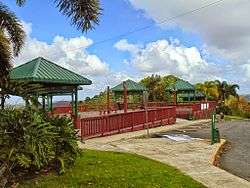Guaynabo, Puerto Rico
Guaynabo (Spanish pronunciation: [ɡwajˈnaβo]) is a municipality in the northern part of Puerto Rico, located in the northern coast of the island, north of Aguas Buenas, south of Cataño, east of Bayamón, and west of San Juan. Guaynabo is spread over 9 wards and Guaynabo Pueblo (the downtown area and the administrative center of the suburb).
Guaynabo | |
|---|---|
City and Municipality | |
 Guaynabo's Central Business District in 2013. | |
 Flag | |
| Nicknames: "Ciudad de los Conquistadores", "Pueblo del Carnaval Mabó", "Primer Poblado de Puerto Rico" | |
| Anthem: "Con Mi Pueblito Sabanero" | |
 Map of Puerto Rico highlighting Guaynabo Municipality | |
| Coordinates: 18°22′00″N 66°06′00″W | |
| Commonwealth | |
| Founded | 1769 |
| Wards | |
| Government | |
| • Mayor | Ángel Pérez Otero (PNP) |
| • Senatorial dist. | 1 - San Juan |
| • Representative dist. | 6 / 9 |
| Area | |
| • Total | 27.1 sq mi (70.2 km2) |
| Population (2010) | |
| • Total | 97,924 |
| • Density | 3,600/sq mi (1,400/km2) |
| Demonym(s) | Guaynabeño(s) |
| Time zone | UTC−4 (AST) |
| ZIP Codes | 00965, 00966, 00968, 00969, 00971, 00970 |
| Area code(s) | 787/939 |
| Major routes | |
| Website | guaynabocity.gov.pr |
Guaynabo is considered, along with its neighbors – San Juan and the municipalities of Bayamón, Carolina, Cataño, Trujillo Alto, and Toa Baja – to be part of the San Juan metropolitan area. It is also part of the larger San Juan-Caguas-Guaynabo Metropolitan Statistical Area, (the largest MSA in Puerto Rico).
The municipality has a land area of 27.13 square miles (70.3 km2) and a population of 97,924 as of the 2010 census.
The studios of WAPA-TV is located in Guaynabo.
History
The first European settlement in Puerto Rico, Caparra, was founded in 1508 by Juan Ponce de León in land that is today part of Guaynabo. Ponce de León resided there as first Spanish governor of Puerto Rico. This settlement was abandoned in 1521 in favor of San Juan. The ruins of Caparra remain and are a U.S. National Historic Landmark. The Museum of the Conquest and Colonization of Puerto Rico, which features artifacts from the site and others in Puerto Rico, is located on the grounds.
The municipality of Guaynabo was founded in 1769 by Pedro R. Davila (P.R.), after a struggle for division from the municipality of Bayamón. Previously, the municipality was known as "Buinabo", a name that means in Taíno "Aquí hay otro lugar de agua dulce" or "Here is another place of fresh water."
In October 2017, after a couple of hurricanes struck Guaynabo, including Hurricane Maria, President Donald Trump visited the area.
Geography
Guaynabo is on the northern side.[1]
Hurricane Maria
Hurricane Maria on September 20, 2017 triggered numerous landslides in Guaynabo with the significant amount of rainfall.[2][3] Due to the municipality's fiscal difficulties, it was not until April 2, 2019, over a year and half later, that the overtime pay owed to municipal workers was paid.[4]
Barrios

Like all municipalities of Puerto Rico, Guaynabo is subdivided into barrios. The municipal buildings, central square and large Catholic church are located in a smaller barrio referred to as "el pueblo", located near the center of the municipality.[5][6][7][8]
Sectors
Barrios (which are like minor civil divisions)[9] in turn are further subdivided into smaller local populated place areas/units called sectores (sectors in English). The types of sectores may vary, from normally sector to urbanización to reparto to barriada to residencial, among others.[10][11][12]
Special Communities
Of the 742 places on the list of Comunidades Especiales de Puerto Rico, the following barrios, communities, sectors, or neighborhoods were in Guaynabo: Amelia, Buen Samaritano, Camarones barrio, Corea, El Polvorín, Honduras, Jerusalén, Los Filtros, Sector El Laberinto, Sector La Pajilla, Sector Los Ratones (Camino Feliciano), Sector San Miguel, Trujillo, Sector Tomé, Vietnam,[13] and Villa Isleña.[14][15]
Demographics
| Historical population | |||
|---|---|---|---|
| Census | Pop. | %± | |
| 1920 | 10,800 | — | |
| 1930 | 13,502 | 25.0% | |
| 1940 | 18,319 | 35.7% | |
| 1950 | 29,120 | 59.0% | |
| 1960 | 39,718 | 36.4% | |
| 1970 | 67,042 | 68.8% | |
| 1980 | 80,742 | 20.4% | |
| 1990 | 92,886 | 15.0% | |
| 2000 | 100,053 | 7.7% | |
| 2010 | 97,924 | −2.1% | |
| U.S. Decennial Census[16] 1920-1930[17] 1930-1950[18] 1960-2000[19] 2010[7] | |||
Tourism
Landmarks and places of interest


- Rancho de Apa (restaurant)[20]
- Centro de Bellas Artes (Guaynabo Performing Arts Center)
- Caparra Ruins
- Caribe Recreational Center
- Iglesia Parroquial de San Pedro Mártir
- La Marquesa Forest Park
- Paseo Tablado
- Mario Morales Coliseum
- San Patricio Plaza
- Caparra Country Club
- Plaza Guaynabo
- Museum of Transportation
- Museo del Deporte
- Fort Buchanan
Economy
Several businesses have their headquarters or local Puerto Rican branches in Guaynabo. El Nuevo Día,[21] Chrysler, Santander Securities, Puerto Rico Telephone, and many sales offices for large US and international firms (such as Total, Microsoft, Toshiba, Puma Energy and others) have their Puerto Rican headquarters in Guaynabo. WAPA-TV (Televicentro) and Univision Puerto Rico have their main studios in Guaynabo.
Crime
Carjackings have been an ongoing problem in Guaynabo, Puerto Rico[23][24][25][26][27] and in 2014 the FBI reported a carjacking that occurred in Camarones.[28]
Climate
| Climate data for Guaynabo, Puerto Rico | |||||||||||||
|---|---|---|---|---|---|---|---|---|---|---|---|---|---|
| Month | Jan | Feb | Mar | Apr | May | Jun | Jul | Aug | Sep | Oct | Nov | Dec | Year |
| Record high °F (°C) | 94 (34) |
93 (34) |
95 (35) |
97 (36) |
96 (36) |
97 (36) |
95 (35) |
98 (37) |
96 (36) |
98 (37) |
95 (35) |
92 (33) |
98 (37) |
| Average high °F (°C) | 84 (29) |
85 (29) |
86 (30) |
87 (31) |
88 (31) |
90 (32) |
90 (32) |
90 (32) |
90 (32) |
89 (32) |
87 (31) |
85 (29) |
90 (32) |
| Average low °F (°C) | 67 (19) |
67 (19) |
67 (19) |
69 (21) |
72 (22) |
73 (23) |
73 (23) |
74 (23) |
73 (23) |
73 (23) |
71 (22) |
68 (20) |
67 (19) |
| Record low °F (°C) | 50 (10) |
45 (7) |
45 (7) |
60 (16) |
59 (15) |
55 (13) |
55 (13) |
60 (16) |
62 (17) |
60 (16) |
55 (13) |
50 (10) |
45 (7) |
| Average precipitation inches (mm) | 4.79 (122) |
3.30 (84) |
3.52 (89) |
5.80 (147) |
7.17 (182) |
4.54 (115) |
6.70 (170) |
6.44 (164) |
7.39 (188) |
6.79 (172) |
8.06 (205) |
6.39 (162) |
70.89 (1,800) |
| Source: weather.com[29] | |||||||||||||
Culture
Festivals and events
Guaynabo celebrates its patron saint festival in April. The Fiestas Patronales de San Pedro Martir is a religious and cultural celebration that generally features parades, games, artisans, amusement rides, regional food, and live entertainment.[1][30]
Other festivals and events celebrated in Guaynabo include:
- Three Kings Festival – January
- Mabó Carnival – February
- Mothers’ Day celebration – May
- National Salsa Day – June
- Fine Arts camp and recreation and sports camp – June
- Bomba and Plena (folkloric music and dance) Festival – October
- Official lighting of Christmas Lights – November
Sports
Guaynabo's old BSN team, the Guaynabo Mets, won national championships in 1980, 1982 and 1989, commanded by the player whom the Mario Morales Coliseum was named after, Mario "Quijote" Morales. The Conquistadores de Guaynabo, or Guaynabo Conquistadores, are the Guaynabo Mets replacement and still play in the Mario Morales Coliseum. The Mets de Guaynabo are the local women's volleyball team that play in the LVSF, or The Liga de Voliebol Superior Femenino. They have not won any championships yet. They also play in the Mario Morales Coliseum. Guaynabo Fluminense FC is Guaynabo's professional soccer team that plays in the Puerto Rico Soccer League. The league started in 2008 and Guaynabo's current position in the league is 4th place. Guaynabo Fluminense FC play their matches at the Jose Bonano Stadium that was originally made for baseball, but became a soccer arena after the Puerto Rico Baseball League was cancelled for the 2008 season. It was at the same year that the Puerto Rico Soccer League was starting to take place. In the 2009 season, Guaynabo Fluminense FC moved to the Sixto Escobar Stadium.
- Mets de Guaynabo (Women's Volleyball) LVSF
- Guaynabo Conquistadores (Basketball) Baloncesto Superior Nacional
- Guaynabo Fluminense FC (Soccer) Puerto Rico Soccer League
Government and infrastructure
The United States Postal Service operates two post offices, Guaynabo and Caparra Heights, in Guaynabo.[31][32]
The Federal Bureau of Prisons operates the Metropolitan Detention Center, Guaynabo in Guaynabo.[33]
Some regions of the city belong to the Puerto Rico Senatorial district I while others belong to the Puerto Rico Senatorial district II. Both of the Districts are represented by two Senators. In 2016, Henry Neumann and Miguel Romero were elected as Senators for District I, while Migdalia Padilla and Carmelo Ríos have been serving as Senators for District II since being elected in 2004.[34]
Mayors
Mayors of Guaynabo from 1969 to present
| Mayor | Term | Party |
|---|---|---|
| Ebenezer Rivera | 1969–1979 | New Progressive Party |
| Alejandro Cruz Ortiz | 1979–1993 | New Progressive Party |
| Héctor O'Neill García | 1993–2017 | New Progressive Party |
| Angel Pérez Otero | 2017–present | New Progressive Party |
Mayors of Guaynabo from 1782 to 1969
Term Name 1782 Cayetano de la Sarna 1800 Pedro Dávila 1812 Dionisio Cátala 1816 Angel Umpierre 1818 Juan José González 1821 Joaquín Goyena 1822 José María Prosis 1823 Simón Hinonio 1825 José R. Ramírez 1827 Antonio Guzmán 1828 Genaro Oller 1836 Andrés Degal 1836 Agustín Rosario 1840 Francisco Hiques 1844 Martínez Díaz 1848 Tomás Cátla 1849 Andrés Vega 1852 Justo García 1856 José Tomás Sagarra 1857 Manuel Manzano 1859 Juan Floret 1859 José Francisco Chiques 1862 Segundo de Echeverte 1862 José de Murgas 1869 Juan J. Caro 1873 Benito Gómez 1874 Manuel Millones 1876 José Otero 1891 Juan Díaz de Barrio 1914 José Ramón 1914 José Carazo 1919 Narciso Val Llovera 1924 Zenón Díaz Valcárcel 1936 Dolores Valdivieso 1944 Augosto Rivera 1948 Jorge Gavillán Fuentes 1956 Juan Román 1964 José Rosario Reyes
Health facilities
Professional Hospital Guaynabo located on Felisa Rincón Avenue (formerly Las Cumbres Avenue), is the newest hospital infrastructure built in Puerto Rico. Guaynabo is the only city in Puerto Rico to have a hospital specialized in advanced vascular surgery.[35] Some of the first and newest procedures performed in Puerto Rico during 2009 were done in Professional Hospital Guaynabo, including the first AxiaLIF surgery for lumbar fusion.[36]
Transportation
The Tren Urbano has only one station in the municipality, Torrimar Station. Guaynabo has a bus network called “Guaynabo City Transport”. There are 63 bridges in Guaynabo.[37]
Education
Guaynabo is home to Atlantic University College, which specializes in new media art.
The Japanese Language School of Puerto Rico (プエルトリコ補習授業校 Puerutoriko Hoshū Jugyō Kō), a weekend Japanese school, previously held its classes in Guaynabo.[38] It closed in March 2006.[39]
International relations
Guaynabo serves as a host city to four foreign consulates with business in Puerto Rico:
Gallery
 Skyline of Guaynabo
Skyline of Guaynabo PR-1 and PR-8834 in Guaynabo
PR-1 and PR-8834 in Guaynabo Metropolitan Detention Center in Guaynabo
Metropolitan Detention Center in Guaynabo
See also
| Wikimedia Commons has media related to Guaynabo, Puerto Rico. |
- List of Puerto Ricans
- History of Puerto Rico
- Did you know-Puerto Rico?
References
- "Guaynabo Municipality". enciclopediapr.org. Fundación Puertorriqueña de las Humanidades (FPH). Archived from the original on 2019-04-04. Retrieved 2019-03-20.
- "Preliminary Locations of Landslide Impacts from Hurricane Maria, Puerto Rico". USGS Landslide Hazards Program. USGS. Archived from the original on 2019-03-03. Retrieved 2019-03-03.
- "Preliminary Locations of Landslide Impacts from Hurricane Maria, Puerto Rico" (PDF). USGS Landslide Hazards Program. USGS. Archived (PDF) from the original on 2019-03-03. Retrieved 2019-03-03.
- "Archived copy". Archived from the original on 2019-06-24. Retrieved 2019-06-24.CS1 maint: archived copy as title (link)
- Picó, Rafael; Buitrago de Santiago, Zayda; Berrios, Hector H. Nueva geografía de Puerto Rico: física, económica, y social, por Rafael Picó. Con la colaboración de Zayda Buitrago de Santiago y Héctor H. Berrios. San Juan Editorial Universitaria, Universidad de Puerto Rico,1969. Archived from the original on 2018-12-26. Retrieved 2019-01-08.
- Gwillim Law (20 May 2015). Administrative Subdivisions of Countries: A Comprehensive World Reference, 1900 through 1998. McFarland. p. 300. ISBN 978-1-4766-0447-3. Retrieved 25 December 2018.
- Puerto Rico:2010:population and housing unit counts.pdf (PDF). U.S. Dept. of Commerce Economics and Statistics Administration U.S. Census Bureau. 2010. Archived (PDF) from the original on 2017-02-20. Retrieved 2019-01-08.
- "Map of Guaynabo" (PDF). Archived from the original (PDF) on 2012-07-30. Retrieved 2018-12-28.
- "US Census Barrio-Pueblo definition". factfinder.com. US Census. Archived from the original on 13 May 2017. Retrieved 5 January 2019.
- "Agencia: Oficina del Coordinador General para el Financiamiento Socioeconómico y la Autogestión (Proposed 2016 Budget)". Puerto Rico Budgets (in Spanish). Retrieved 28 June 2019.
- Rivera Quintero, Marcia (2014), El vuelo de la esperanza: Proyecto de las Comunidades Especiales Puerto Rico, 1997-2004 (first ed.), San Juan, Puerto Rico Fundación Sila M. Calderón, ISBN 978-0-9820806-1-0
- "Leyes del 2001". Lex Juris Puerto Rico (in Spanish). Retrieved 24 June 2020.
- "Archived copy". Archived from the original on 2019-06-28. Retrieved 2019-06-28.CS1 maint: archived copy as title (link)
- "Comunidades Especiales de Puerto Rico" (in Spanish). 8 August 2011. Archived from the original on 24 June 2019. Retrieved 24 June 2019.
- Rivera Quintero, Marcia (2014), El vuelo de la esperanza:Proyecto de las Comunidades Especiales Puerto Rico, 1997-2004 (Primera edición ed.), San Juan, Puerto Rico Fundación Sila M. Calderón, p. 273, ISBN 978-0-9820806-1-0
- "U.S. Decennial Census". United States Census Bureau. Archived from the original on February 13, 2020. Retrieved September 21, 2017.
- "Table 3-Population of Municipalities: 1930 1920 and 1910" (PDF). United States Census Bureau. Archived (PDF) from the original on August 17, 2017. Retrieved September 21, 2017.
- "Table 4-Area and Population of Municipalities Urban and Rural: 1930 to 1950" (PDF). United States Census Bureau. Archived (PDF) from the original on August 30, 2015. Retrieved September 21, 2014.
- "Table 2 Population and Housing Units: 1960 to 2000" (PDF). United States Census Bureau. Archived (PDF) from the original on July 24, 2017. Retrieved September 21, 2017.
- "Archived copy". Archived from the original on 2019-09-28. Retrieved 2019-09-28.CS1 maint: archived copy as title (link)
- "Contáctanos - El Nuevo Día". www.elnuevodia.com. Archived from the original on 24 June 2019. Retrieved 24 June 2019.
- "Iberia Around the World." Iberia. Accessed September 11, 2008. "In the rest of the world - Puerto Rico" - "San Juan de Puerto Rico. City office - Metro Office Park Calle 1 Lote 3 Oficina 102 Guaynabo, Puerto Rico 00968."
- "Carjacking en Guaynabo". La Perla del Sur. 3 March 2019. Archived from the original on 23 June 2019. Retrieved 24 June 2019.
- Rico, Metro Puerto. "Sacan familia de auto para hacer carjacking en Guaynabo". Metro. Archived from the original on 23 June 2019. Retrieved 23 June 2019.
- PR, Por TELEMUNDO. "Video: Carjacking en centro comercial de Guaynabo - Telemundo Puerto Rico". Telemundo PR. Archived from the original on 23 June 2019. Retrieved 23 June 2019.
- VOCERO, Nicole Candelaria, Especial para EL. "Investigan carjacking en Guaynabo". El Vocero de Puerto Rico. Archived from the original on 23 June 2019. Retrieved 23 June 2019.
- "Mujer víctima de carjacking a punta de pistola en Guaynabo". Primera Hora. 19 January 2019. Archived from the original on 23 June 2019. Retrieved 23 June 2019.
- "Arrests of Elvin Manuel Otero Tarzia, Sebastian Angelo Saldana, Kevin Rivera Ruiz, and a Male Juvenile". FBI. Archived from the original on 1 December 2015. Retrieved 23 June 2019.
- "Average Conditions Guaynabo". weather.com. Archived from the original on January 9, 2019. Retrieved January 8, 2019.
- J.D. (2006-05-02). "Guaynabo". Link To Puerto Rico.com (in Spanish). Retrieved 2020-07-18.
- "Post Office Location - GUAYNABO Archived 2010-03-15 at the Wayback Machine." United States Postal Service. Retrieved on May 19, 2010.
- "Post Office Location - CAPARRA HEIGHTS Archived 2010-03-15 at the Wayback Machine." United States Postal Service. Retrieved on May 19, 2010.
- "MDC Guaynabo Contact Information Archived 2009-05-07 at the Wayback Machine." Federal Bureau of Prisons. Retrieved on January 12, 2010.
- Elecciones Generales 2012: Escrutinio General Archived 2013-01-15 at the Wayback Machine on CEEPUR
- "New hospital and medical building developing in Guaynabo" Caribbean Business Newspaper, Issued : 06/12/2008, By : LISA NIDO NYLUND
- "Avanza la cirugía de la columna" Primera Hora Newspaper, Alejandra M. Jover Tovarra - 10/02/2009
- "Guaynabo Bridges". National Bridge Inventory Data. US Dept. of Transportation. Archived from the original on 22 February 2019. Retrieved 20 February 2019.
- "北米の補習授業校一覧" (). MEXT. January 2, 2003. Retrieved on April 6, 2015. (Puerto Rico) "(学校所在地) CALLEDELFOS #2119 ALTO APOLO GUAYNABO P.R 00969,U.S.A."
- "関係機関へのリンク" (Archive). The Japan School of Doha. Retrieved on March 31, 2015. "ポート・モレスビー補習授業校(2009年8月休校)" and "(ニューメキシコ)アルバカーキ補習授業校(休校)" and "(プエルトリコ)プエルトリコ補習授業校(2006年3月閉校)"